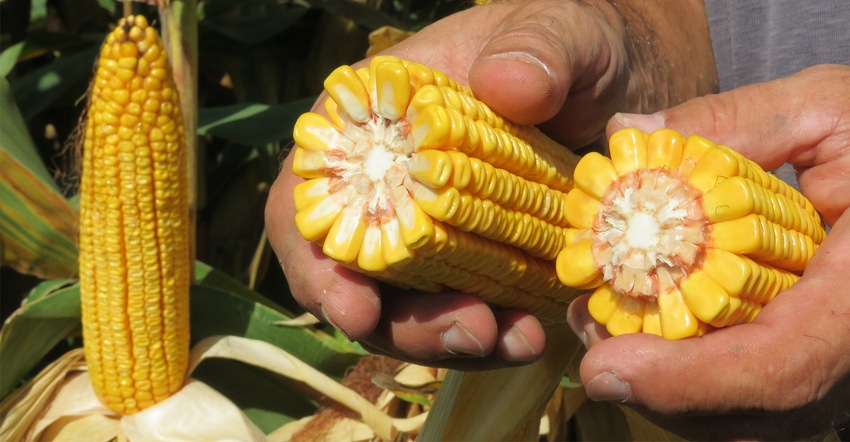October 8, 2019

During the 2019 crop season, several Iowa farmers were featured in the 4R Plus Crop Report, appearing on Wallaces Farmer website. As harvest gets underway this fall, beginning with wet weather in early October, three of these farmers share their advice on limiting or avoiding soil compaction in fields.
First, all three pointed out that the soil moisture profile in early October is saturated across much of the state, very similar to last fall.
The 4R Plus program is a science-based educational effort to increase awareness and provide information about crop nutrient stewardship, and soil and water conservation practices to crop advisers and farmers. All three farmers agree that using 4R Plus practices can improve soil health, crop yields and water quality.
Doug Adams, a no-till and strip-till farmer in Humboldt County in northern Iowa, encourages farmers to rethink their tillage practices. “Last fall when we had wet conditions, we noticed we could run the combine in fields and not leave ruts like the farms that do tillage ahead of soybeans,” he says. “Our improved soil structure is a result of no-till and strip till. It helps support the load and reduces soil compaction since the soil acts more like a mattress and will spring back up after crossing it with a normal load.”
He adds, “We load our semis in the field with a grain cart, and most of the loads go out one driveway. I do not till the area even where we fill the trucks, and you cannot see any difference in the growth of soybeans there this year in terms of compaction. When I invite farmers to see my no-till and cover crop fields, I show them the area where I fill the trucks with grain from the combine. They are impressed with the crops and can’t tell where we filled the trucks the previous fall.”
Build soil structure
Roger Zylstra farms in Jasper County in central Iowa and says his soil had some room for water after being mostly dry in July and August. He no-tills on fields with a corn-soybean crop rotation, and vertical-tills on continuous corn acres. He says the best thing to support the load of machinery during harvest is to work on improving the soil structure.
“It takes several years to make changes, but if we don’t get started, nothing will change,” says Zylstra, about switching tillage systems. “It’s been a challenging year, and it looks like harvest this fall will also be challenging. Something that helps when the ground is saturated is to keep the truck and the wagon traffic on the end of the field.”
Unload combine at field’s edge
Curt Mether has used a no-till system on his farms in Harrison and Monona counties for more than 20 years. The western Iowa farmer says the effects of compaction, caused by being in fields with heavy equipment when soil conditions are less than ideal, can be long lasting.
“An auger cart can weigh 40,000 to 60,000 pounds. That’s a lot of weight to haul across the field, especially if the ground is a little wet,” he says.
Instead of following the combine across the field with an auger cart and unloading the combine into the cart on the go, Mether encourages farmers to think about emptying the combine before it’s full and unloading the grain into a truck or wagon at the edge of the field. “These options might not work for everyone, but they may work for some,” he adds.
Concerns about cover crop growth
Adams is getting questions from farmers who have seeded cover crops into soybeans during the growing season. “People are concerned about the growth of the cover crop, and if it will affect soybean harvest,” he says.
“Typically, the cover crop is flimsy and green, which doesn’t cut easily with the sickle on the bean head,” he says. “A little bit of the cover crop may go into the combine head along with the beans, but the dry bean stems just keep it flowing through the combine. The green cover crop can also help keep the dust down when harvesting soybeans.”
To learn more about 4R Plus and resources available for getting started, visit 4rplus.org.
Nutrient stewardship
4R Plus combines the 4R’s of nutrient stewardship — applying the right source of fertilizer at the right rate and right time and in the right place — with the “Plus” conservation practices like cover crops, no-till and edge-of-field practices such as saturated buffers and bioreactors.
These combined practices are needed to achieve the nitrogen and phosphorus loss goals of the Iowa Nutrient Reduction Strategy. This strategy calls for a 45% reduction in total nitrogen and phosphorus loads going into Iowa waters, with 41% and 29% reductions in nitrogen and phosphorus loads, respectively, from nonpoint sources, such as agricultural production.
Source: 4R Plus, which is responsible for information provided and is wholly owned by source. Informa Business Media and subsidiaries aren’t responsible for content in this information asset.
You May Also Like




